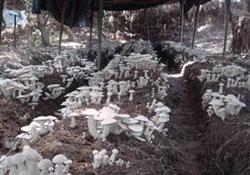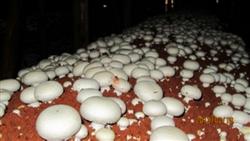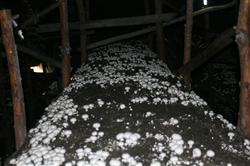How to grow high-temperature mushrooms?

How to grow high-temperature mushrooms? Please guide high-temperature mushrooms, also known as big fat mushrooms, high-temperature mushrooms, double-ring mushrooms, which is different from double-spore mushrooms in classification. High temperature mushroom has the following characteristics: first, it has stronger adaptability and heat resistance than Agaricus bisporus, and the temperature of mycelial growth is 5 ℃ higher than that of Agaricus bisporus, that is, Rose grows faster at 30 ℃ than at 26 ℃, and the fruiting body still has a higher fruiting rate at 23 ℃. Second, high-temperature mushroom has strong resistance, it is suitable for extensive cultivation, heat-resistant, drought-resistant, water-resistant, carbon dioxide-resistant, and resistant to nematodes and mushroom diseases. it even has strong resistance to pathogenic diseases of Agaricus bisporus, such as Pomosporium, walnut fleshy bacteria, etc.; third, the mushroom opens umbrella late, injury is not easy to change color, extrusion resistance, easy storage and transportation. (1) seed production: high temperature mushroom is suitable for growth on PDA medium. According to the dosage of PDA medium and adding 1015% glucose, the mycelium growth will be promoted. The high temperature mushroom grew well on the dung grass medium, especially on the dung grass after secondary fermentation. In the production of seeds, when the mycelium is full of bottles, the seeds should be sown after 20-30 days, which is better than that of ordinary wheat seeds for 10-15 days. This is different from Agaricus bisporus. (2) preparation: 1. Formula: please refer to the formula of Agaricus bisporus. 2000 kg of dried rice straw, 1000 kg of dried cow dung, 80 kg of cake powder, 30 kg of urea, 30 kg of sulfuric acid, 60 kg of superphosphate, 50 kg of gypsum, 30 kg of calcium sulfate and 60 kg of lime were used. 2. Stacking: 2% lime is added during stacking, and 1% ammonium sulfate, 2% calcium phosphate and 1% calcium sulfate are added after 2 to 3 days. When turning the pile, add it evenly to compost, pile it into 1 meter wide and 1.2 meters wide, one layer of straw and one layer of cow dung, and add water and auxiliary materials evenly from the third layer. Turn the pile once every 3 days, and finally turn over once again, a total of 4 times. The first three times respectively add auxiliary materials, somersault should be sprayed with water, so as to tightly pinch the culture material with water dripping. 3. Go to bed: close the door of mushroom window and disinfect it with aerosol disinfectant. Spread 6.7 cm thick rice straw at the bottom of the bed, add 10: 15% wheat bran or rice bran, 2% superphosphate, and then add appropriate amount of water (55% water content). The stacked culture material is piled on the bed surface which has been covered with straw, the height is 8 cm 10 cm, the middle part is 10 cm, and the bed surface forms an arc. The paving material should not be too thick, otherwise it will increase the material temperature and lead to the occurrence of diseases and insect pests in a large area. 4. Secondary fermentation: two days after going to bed, the temperature begins to rise, and the secondary fermentation is carried out immediately after a slight decrease. Steam was put into the mushroom room to keep the temperature of the material above 60 ℃ for 12-18 hours. When the temperature rises to 69 ℃, there is no need to heat it up. After 18 hours, the temperature dropped to the range of 45 ℃ ~ 52 ℃ and kept for 4-5 days, the secondary fermentation was completed. (3) sowing: pay attention to maintaining indoor ventilation before and after sowing, properly open the ventilation windows at both ends of the mushroom room, and sow seeds when the temperature is 26 ℃ and the bed temperature is 30 ℃. The sowing amount of high-temperature mushroom should be slightly larger than that of Agaricus bisporus, which can be sowed according to the conventional method and sowed again after hole sowing, which can not only prevent the spread of diseases and insect pests, but also promote the mycelium to extend to the material layer, which is beneficial to cover the soil earlier and increase the yield. (4) soil covering: soil covering materials should be strictly disinfected. Spray 10 kg of 5% formaldehyde liquid per cubic meter of dry soil, cover with film and sterilize for 24 hours, then mix in 1 / 2% lime. Soil covering materials should be combined with disinfection and pre-wetting before going to bed. The amount of pre-wetting water is 50% to 70% of the normal water after covering the soil. Soil covering time, spring sowing should be 30 days after sowing, autumn sowing should be 20 days after sowing. In short, the soil should be covered after the mycelium is almost full of the bed. The thickness of the cover is 3cm to 4cm and is kept moist from time to time. The soil cover is divided into 2 to 3 times according to the total amount. Once the bed is dry after each cover, spray fine water again. (5) mushroom production: ventilation should be reduced a few days before mushroom production. Water spraying should be sufficient and the number of times should be increased appropriately. When the fruiting body appears, the heavy water should be sprayed once, and the indoor humidity should be kept at 750.85%. Bacterial spot disease is easy to occur in high temperature and humidity. Apply lime powder directly on the mushroom bed, or spray 0.1% bleaching powder on the mushroom bed to improve the PH value of the mushroom bed. Mushroom rooms should be kept clean and sterilized and insecticidal pesticides are often sprayed on the ground or four walls. Click to get more mushroom planting techniques click to get more edible mushroom cultivation techniques
- Prev

How to top-fertilize mushrooms to achieve high yield?
How to top-fertilize mushrooms to achieve high yield? Please introduce the method of growing mushrooms to have a high yield, proper topdressing is the key, and now introduce several preparation methods of mushroom topdressing solution: 1. Mushroom root soup. Wash the mushroom feet and crushed mushrooms cut off during harvesting and processing, cut into thin slices, add 1-1.5 kg of water per kilogram, and boil 15.
- Next

How can planting Agaricus bisporus in greenhouse produce high yield?
How can planting Agaricus bisporus in greenhouse produce high yield? Please guide Agaricus bisporus is the earliest cultivated, largest area and most productive global edible fungus in the world. Agaricus bisporus is fleshy, tender, nutritious and delicious. At the same time, Agaricus bisporus is a more exported agricultural by-product. -- preparing materials 1. Raw materials and.
Related
- Fuxing push coffee new agricultural production and marketing class: lack of small-scale processing plants
- Jujube rice field leisure farm deep ploughing Yilan for five years to create a space for organic food and play
- Nongyu Farm-A trial of organic papaya for brave women with advanced technology
- Four points for attention in the prevention and control of diseases and insect pests of edible fungi
- How to add nutrient solution to Edible Fungi
- Is there any good way to control edible fungus mites?
- Open Inoculation Technology of Edible Fungi
- Is there any clever way to use fertilizer for edible fungus in winter?
- What agents are used to kill the pathogens of edible fungi in the mushroom shed?
- Rapid drying of Edible Fungi

